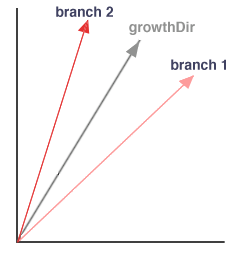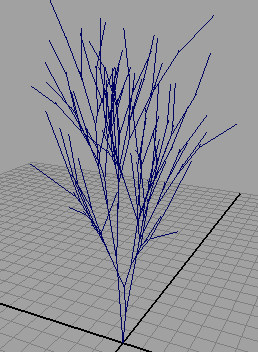|
//==============================================
// aimY
//==============================================
proc float[] aimY(vector $vec)
{
float $out[2];
float $xAngle;
float $zAngle;
float $xyLength;
float $vecLength;
$xyLength = sqrt(($vec.x) * ($vec.x) +
($vec.y) * ($vec.y));
$vecLength = sqrt(($vec.x) * ($vec.x) +
($vec.y) * ($vec.y) +
($vec.z) * ($vec.z));
// $xyLength will be zero when $vec is pointing
// along the +z or -z axis
if($xyLength == 0)
$zAngle = ($vec.x) > 0 ? deg_to_rad(90) : deg_to_rad(-90);
else
$zAngle = acos(($vec.y)/$xyLength);
$xAngle = acos($xyLength/$vecLength);
$xAngle = ($vec.z) > 0 ? $xAngle : -$xAngle;
$out[0] = rad_to_deg($xAngle);
$zAngle = ($vec.x) > 0 ? -$zAngle : $zAngle;
$out[1] = rad_to_deg($zAngle);
return $out;
}
//==============================================
// vectorOnCircle
//==============================================
proc vector vectorOnCircle(float $rad)
{
// find a random vector within a 2 * rad square
float $x = rand(-$rad, $rad);
float $y = 0;
float $z = rand(-$rad, $rad);
vector $vec = <<$x, $y, $z>>;
// convert to a unit vector - this will place
// head of the vector on a circle of radius 1
$vec = unit($vec);
// scale it by $rad
$vec = $vec * $rad;
return $vec;
}
//==============================================
// reflect
//==============================================
proc vector reflect(vector $i, vector $n)
{
$i = unit($i);
$n = unit($n);
return $i - 2 * dot($i, $n) * $n;
}
//==============================================
// tree
//==============================================
proc tree(int $depth,
vector $base,
vector $growthDir,
float $branchAngle,
float $branchLen)
{
if($depth <= 0)
return;
// STEP 1 Find the size of a circle such that if it was
// located at the end of the branch it would define
// a cone whose apex angle equals twice the "branchAngle".
$rad = $branchLen * sin(deg_to_rad($branchAngle));
// STEP 1.1 Randomly choose a point on a circle
vector $vec = vectorOnCircle($rad);
// STEP 1.2 Transform the point on the circle so that
// its "branchLen" units up the world y-axis
vector $x_axis = <<1,0,0>>;
vector $y_axis = <<0,1,0>>;
vector $z_axis = <<0,0,1>>;
$vec = $vec + <<0, $branchLen, 0>>;
// STEP 1.3 Find the x-axis/z-axis rotations that will
// align the branch $vec to the "growthDir".
float $angle[2] = aimY($growthDir);
$vec = rot($vec, $x_axis, deg_to_rad($angle[0]));
$vec = rot($vec, $z_axis, deg_to_rad($angle[1]));
$vec = <<($vec.x), ($vec.y), ($vec.z)>>;
// STEP 1.4 Locate the end of the branch relative to the
// base of the branch.
vector $end1 = $base + $vec;
// STEP 1.5 Finally, draw the curve segment that "represents"
// the first branch.
curve -d 1 -p ($base.x) ($base.y) ($base.z)
-p ($end1.x) ($end1.y) ($end1.z);
// Recurse to the next branch
tree($depth - 1, $end1, $vec, $branchAngle, $branchLen * 0.6);
// STEP 2 Define the second branch as if it were a
// reflection of the first branch first about the "growthDir"
$vec = reflect(-$vec, $growthDir);
$vec = <<($vec.x), ($vec.y), ($vec.z)>>;
// STEP 2.1 Locate the end of the branch relative to the
// base of the branch.
vector $end2 = $base + $vec;
// STEP 2.2 Finally, draw the curve segment that "represents"
// the second branch.
curve -d 1 -p ($base.x) ($base.y) ($base.z)
-p ($end2.x) ($end2.y) ($end2.z);
// Recurse to the next branch
tree($depth - 1, $end2, $vec, $branchAngle, $branchLen * 0.6);
}
select -all;
delete;
//seed(1);
vector $begin = <<0,0,0>>;
vector $dir = <<0,1,0>>;
float $angle = 13;
float $len = 2;
tree(7, $begin, $dir, $angle, $len);
|






